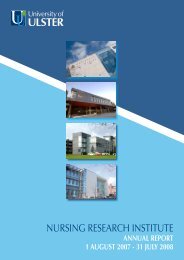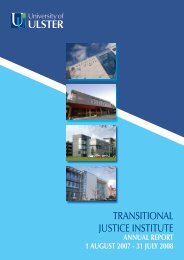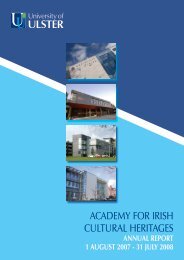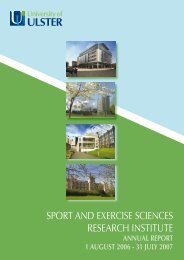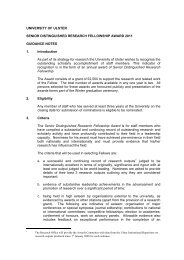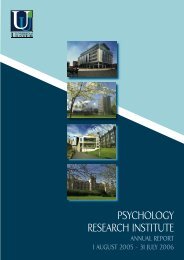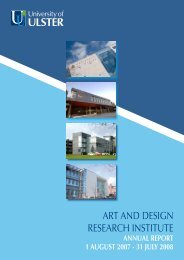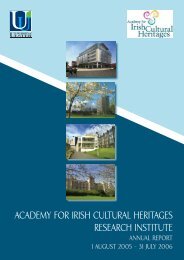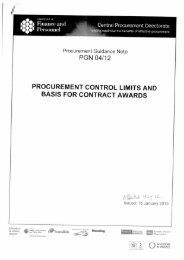environmental sciences research institute - University of Ulster
environmental sciences research institute - University of Ulster
environmental sciences research institute - University of Ulster
Create successful ePaper yourself
Turn your PDF publications into a flip-book with our unique Google optimized e-Paper software.
Brian Rippey<br />
References<br />
Rippey, B., N., Anderson, N. J., Renberg, I., and Tom Korsman, T., Estimating the whole-lake accumulation rate <strong>of</strong> organic<br />
carbon, major cations, phosphorus and heavy metals in sediment, Journal <strong>of</strong> Paleolimnology, DOI 10.1007/s109330-007-<br />
9080-x, 2007<br />
Research into phosphorus transfers from land to water<br />
Managing the eutrophication <strong>of</strong> fresh, transitional and coastal waters caused by excessive transfers <strong>of</strong> nutrients from land<br />
to water remains one <strong>of</strong> the key water quality challenges <strong>of</strong> the 21st Century. In Ireland and the rest <strong>of</strong> the EU, managing<br />
eutrophication will form part <strong>of</strong> (International) River Basin District Management Plans and Programmes <strong>of</strong> Measures<br />
under the Water Framework Directive with a view to attaining at least ‘good’ ecological status by 2015.<br />
The drivers <strong>of</strong> cultural eutrophication are largely excessive inputs <strong>of</strong> phosphorus (P) and nitrogen (N) from a multiplicity<br />
<strong>of</strong> sources and each having importance according to water-body type, hydrological regime (and connectivity) and sourcemagnitude<br />
in any given catchment or watershed.<br />
Phosphorus is generally considered to be the greater threat to the ecological status <strong>of</strong> freshwaters, altering macrophyte<br />
diversity and eventually oxygen regimes, macro-invertebrate and fish ecology. Nitrogen is considered to be the limiting<br />
nutrient in transitional and coastal waters for similar reasons with the extra implications for human health impacts<br />
resulting from excessive nitrate-nitrogen concentrations in drinking water supplies. Both nutrients have inorganic and<br />
organic origins; the added implication <strong>of</strong> organically sourced N and P is the risk <strong>of</strong> faecal (and bacterial pathogen)<br />
contamination in drinking water source supplies and recreational waters. The major sources can therefore be summarised<br />
as those originating from human and animal faecal and industrial wastes and those originating from inorganic fertilisers.<br />
These can be further categorised as originating from diffuse (non-point) or point sources in the landscape; or being<br />
dependent on hydrological processes for transfer, or independent, respectively.<br />
Research published by ESRI in 2007 in this area <strong>of</strong> water quality science were formed from an interlinked series <strong>of</strong><br />
scientific investigations centred on the NERC JIF funded Oona Water catchment hydrometeorological infrastructure, in<br />
Co. Tyrone, under the Catchment Hydrology and Sustainable Management (CHASM) initiative.<br />
Linking this CHASM infrastructure in projects funded by the Irish Environmental Protection Agency, Douglas et al. (2007)<br />
investigated the spatial patterns <strong>of</strong> phosphorus and sediment transfers. The work delineated phases <strong>of</strong> non-storm and<br />
storm transfers and highlighted the role <strong>of</strong> sediment as an influential vector <strong>of</strong> transfer from catchment soils, despite the<br />
catchment being wholly under grassland. Results also showed the dominant role that iron (Fe) and manganese (Mn) is<br />
likely to have in controlling particulate P transfer at the scale from 1st to nth order channels and that increasing soluble<br />
losses with increasing catchment scale were more likely to be contributed from other, non-soil, sources – a theme that<br />
is discussed below.<br />
Datasets and conceptualisations <strong>of</strong> catchment processes from this work were also used in a modelling effort using<br />
three physically distributed hydrochemistry models (SHETRAN, SWAT and HSPF). Nasr et al (2007) (<strong>University</strong> College<br />
Dublin collaborators) showed that the partitioning <strong>of</strong> hydrometeorological processes and hydrochemical processes<br />
within complex models could not provide a generic model structure for use in multiple catchments when validated with<br />
extensive time-series data. Instead it was shown that HSPF provided an optimum modelling solution for hydrological<br />
processes and SWAT a similar optimum solution for P transfers. A combination model using elements <strong>of</strong> several models<br />
may the most effective and this work is ongoing.<br />
Two <strong>of</strong> the several conclusions <strong>of</strong> the EPA/CHASM linked projects were firstly to work towards monitoring P transfers<br />
at a higher resolution and secondly to identify the causes <strong>of</strong> high, ambient P concentrations during non-storm periods.<br />
Higher resolution monitoring recognises that most nutrient transfers occur in very short time-scales – <strong>of</strong>ten called<br />
the 80:20 rule – linked to high energy storm events that are difficult to monitor. Phosphorus monitoring by ion specific<br />
probes is not technologically possible and so Jordan et al. (2007) applied a wet chemistry continuous total P (TP)<br />
<br />
18



